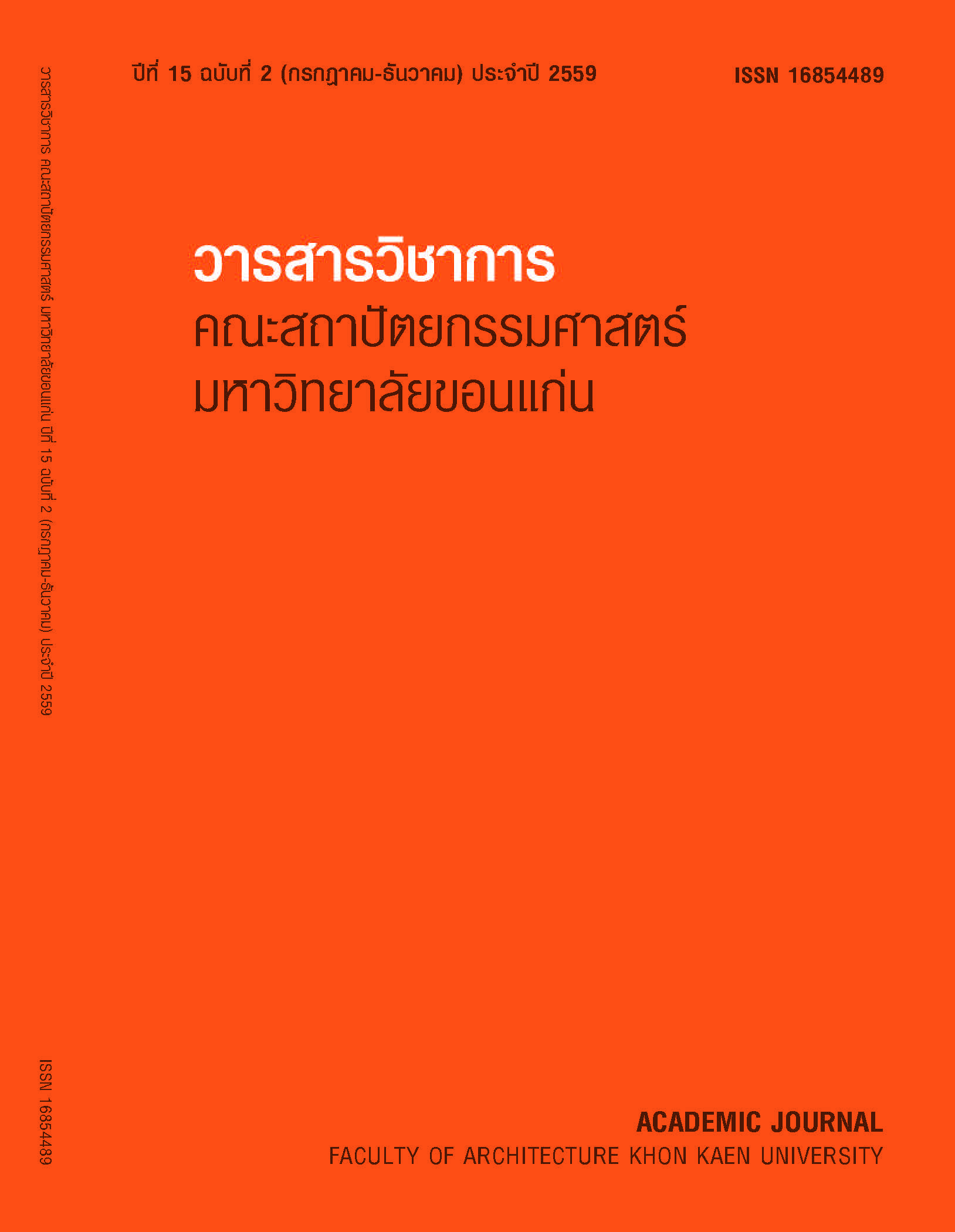แนวคิดสาธารณะของพื้นที่สาธารณะในเมือง - Public Concepts of Urban Public Space
คำสำคัญ:
พื้นที่สาธารณะ, ความเป็นสาธารณะ, การเข้าถึง, ตัวแทน, ผลประโยชน์บนพื้นที่, Public Space, Publicness, Access, Agency, Area Interest,บทคัดย่อ
บทคัดย่อ
พื้นที่สาธารณะเป็นองค์ประกอบที่สำคัญของเมืองที่ส่งเสริมให้เกิดคุณภาพชีวิตและรองรับความต้องการที่ หลากหลาย ซึ่งจำเป็นต้องอาศัยความเข้าใจทั้งจากมุมมองสถาปัตยกรรม การออกแบบชุมชนเมือง สังคมศาสตร์ ประวัติศาสตร์ และภูมิศาสตร์ ผ่านทฤษฎีที่เกี่ยวข้องที่มีอิทธิพลต่อทิศทางการมองพื้นที่สาธารณะ จุดประสงค์ของ บทความนี้เป็นการทบทวนแนวความคิดการศึกษาความเป็นสาธารณะของพื้นที่สาธารณะทางกายภาพจากมุมมองที่ หลากหลายในเมือง จากการศึกษาพบประเด็นที่น่าสนใจจากนักคิดที่หลากหลายความคิดอย่าง อาเร็นท์ (Arendt, 1958) ที่กล่าวว่า “พื้นที่สาธารณะ” เป็นพื้นที่ของการแสดงออกของสังคมประชาธิปไตย ส่วนฮาเบอร์มาส (Habermas, 1989) กล่าวถึงการเปลี่ยนแปลงทางสังคมที่ทำให้เกิดปริมณฑลสาธารณะ แบบใหม่ผ่านเทคโนโลยีการสื่อสารอย่าง เสรีที่ส่งผลให้เกิดการลดทอนและทำลายความเป็นประชาธิปไตยทางกายภาพของพื้นที่สาธารณะที่เป็น “พื้นที่จริง” ลง นำไปสู่การสูญเสียการเป็นพื้นที่สาธารณะและไม่ส่งผลดีต่อคุณภาพชีวิตสาธารณะในเมืองอย่างต่อเนื่อง เมื่อ พิจารณาถึงบริบทเมืองในปัจจุบันจะพบว่าทุกวันนี้ชีวิตสาธารณะมีความเชื่อมโยงเกี่ยวข้องกันระหว่างความเป็น สาธารณะและความเป็นส่วนตัวบนพื้นที่สาธารณะนำมาสู่แนวคิดที่น่าสนใจของเบนน์ และกัส (1983) ที่เสนอต้นแบบ แนวคิดเพื่อค้นหาความแตกต่างระหว่าง “สาธารณะ” และ “ส่วนตัว” ด้วยหลักเกณฑ์ 3 ส่วน ได้แก่ การเข้าถึงตัวแทน และผลประโยชน์ ผลจากการศึกษาพบว่าเงื่อนไขสำคัญในการนิยามความเป็นสาธารณะนั้นมีความสัมพันธ์ของคู่ตรงข้ามอย่าง “สาธารณะ” และ “ส่วนตัว” บนพื้นที่สาธารณะทางกายภาพที่ต้องพิจารณากับหลักเกณฑ์ 3 ส่วนที่กล่าวมาแล้ว บน พื้นที่สาธารณะร่วมกับพื้นที่สาธารณะทางสังคมที่เป็นอีกปัจจัยในการสร้างสรรค์พื้นที่สาธารณะในเมืองสมัยใหม่
ABSTRACT
Public space is a critical element of the city which promotes and supports quality and
diversity of life. To enhance understanding of the concept of urban public space requires
integrated perspectives from various fields: architecture, urban design, social sciences, history, and geography. This study aims to examine theories concerning with the concept of publicness of urban space from physical dimensions.
The study finds interesting points of variously significant thoughts from many thinkers such
as Arendt’s public sphere (1958), which lies in a place of civil expression. Habermas (1989)
moreover mentioned that social change produces a new kind of public sphere that is produced by free communication technology that reduces and destructs the democratization of the physical public space of spatial reality. This technological phenomenon constantly results in loss publicness and quality of public life on public space. Considering the current context, public life relates to dialectics of ‘public’ and ‘private’ on a public space. According to the concept of the public and the private on public space, Benn and Gaus Gaus (1983) proposed the remarkable model concept to distinguish differences between public and private spaces with three conditions: access, agency, and interest.
The study result finds out that a key definition of publicness concerns with dialectical
relationships between the public and the private on physical public space. Being publicness of space could consider criteria of access, agency, and interest on a public space which cooperate with social space as another factor, in order to generate public space in a contemporary city.
ดาวน์โหลด
เผยแพร่แล้ว
รูปแบบการอ้างอิง
ฉบับ
ประเภทบทความ
สัญญาอนุญาต
ทัศนะและข้อคิดเห็นของบทความที่ปรากฏในวารสารฉบับนี้เป็นของผู้เขียนแต่ละท่าน ไม่ถือว่าเป็นทัศนะและความรับผิดชอบของกองบรรณาธิการ




